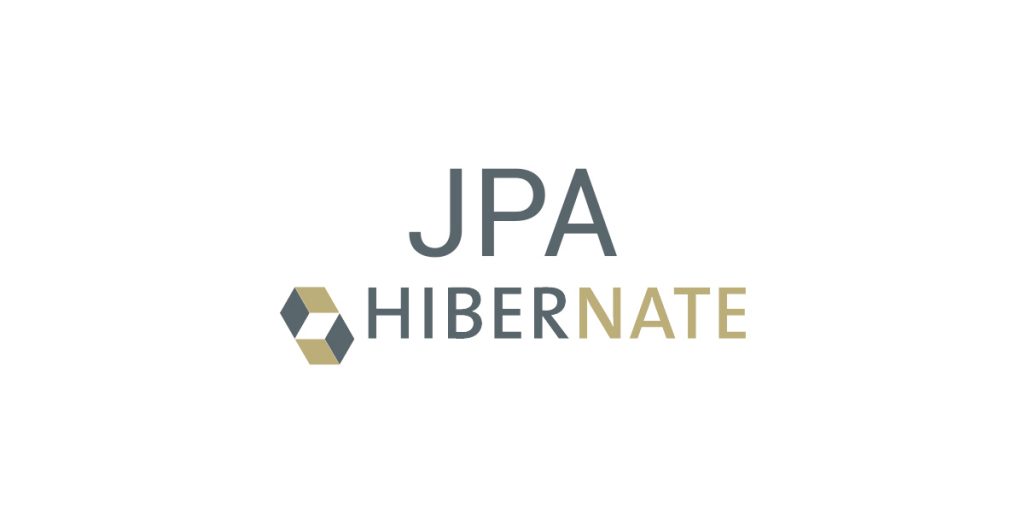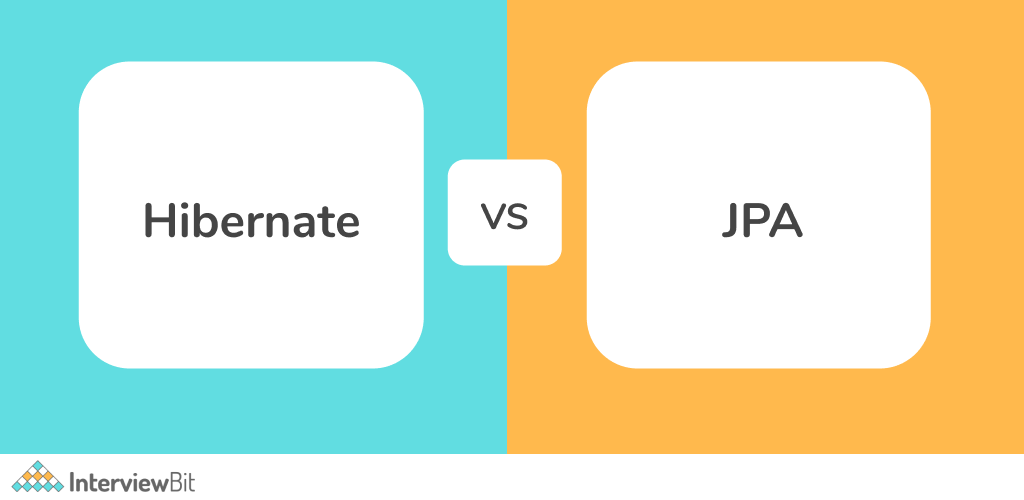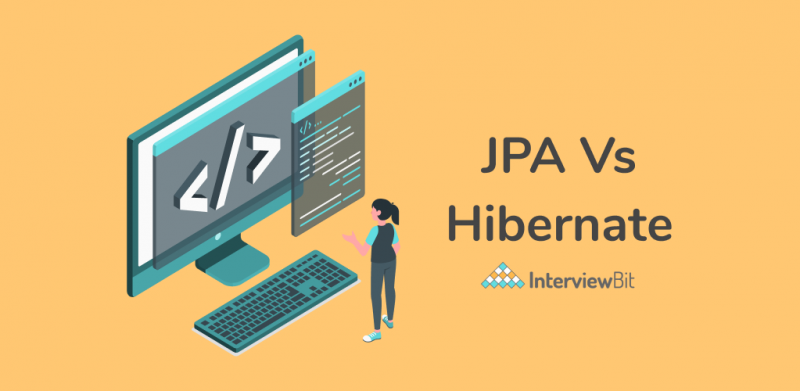ORM (Object-Relational Mapping) is the method of querying and manipulating data from a database using an object-oriented paradigm/programming language. By using this method, we are able to interact with a relational database without having to use SQL. Initially released on 11 May 2006, Java Persistence API (JPA), is a Java specification that deals with persistent data in Java applications. JPA is primarily concerned with the ORM layer. One of the most widely used Java ORM frameworks is Hibernate. In nearly twenty years since its first release, Hibernate has maintained excellent community support and has released new versions on a regular basis. Hibernate implements a standard version of JPA, with a few new features unique to Hibernate. In short, the main difference between Hibernate and JPA is that Hibernate is a framework whereas JPA is an API specification focused mainly on ORM.
The purpose of this article is to get a clear understanding of what JPA and Hibernate are, as well as what is the difference between JPA and Hibernate. To begin with, let us explore the concepts of JPA and Hibernate.
What is JPA?

For almost every application, you need to perform database operations like storing and retrieval for handling a large amount of data. This is a tedious task that usually takes a lot of time to be done. So, to reduce the burden of interacting with databases, JPA is an excellent option for Java developers. It stands for Java Persistence API, a Java specification that provides an object mapping facility to relational databases for Java applications. It provides a mechanism for managing persistence and object-relational mapping. JPA defines these mappings internally rather than depending on vendor-specific implementations. It does not do operations by itself; instead, it uses ORM (Object Relational Mapping) tools like TopLink, Hibernate, etc.
Confused about your next job?
JPA represents how to define POJO (Plain Old Java Object) as an entity and manage it with relations using some meta configurations. They are defined either by annotations or by XML files. JPA is compatible with operating both inside and outside of Java EE (Enterprise Edition) containers; on the other hand, it is used for testing application functions for Java SE versions.
Following are the elements of JPA used for easy persistence management:
- Persistence unit
- EntityManagerFactory
- Persistence context
- EntityManager
- Entity objects
Features of JPA
Following are the features of Java Persistence API:
Stored Procedure Query: It is a way to implement stored procedure calls without the use of annotations. To use this feature, EntityManager is extended by the createStoredProcedureQuery(String procedureName, Class… resultClasses) method.
Constructor Result Mapping: For mapping the result of the query to the existing constructor call, you can use @ConstructorResult annotation. It is an addition to @SqlResultSetMapping.
JPQL Enhancements: There are some additions to JPQL. You can use the ON keyword to define additional join parameters, the FUNCTION keyword to call database functions, and the TREAT keyword to downcast the entities.
Bean Validation: You have to annotate with the javax.validation.constraints annotations to the fields which require the validations. If the fields are failed in the validation, the values are not presented to the back end.
JDBC Properties: There are several properties defined in the persistence.xml that have become standard for JPA specification. In JPA 1, these properties are vendor-specific, but JPA 2 makes it the standard. Some of the important properties are:
- javax.persistence.jdbc.driver – the fully qualified name for the driver class
- javax.persistence.jdbc.URL – driver-specific URL
- javax.persistence.jdbc.user – the username used for database connection.
- javax.persistence.jdbc.password – the password for validation of database connection.
Shared Cache: JPA 2 version provides a standard for the shared cache mechanism. In this mechanism, entities can be stored in the persistence layer to share among all other contexts if they are long-lived. JPA accomplishes this feature by invoking the standard cache interface from EntityManagerFactory.getCache() method.
Database Schema Generation: Before JPA 2.1 version, developers were using vendor-specific configuration parameters for defining database setup in the persistence.xml file, but now we have the following parameters that help to set up the database:
- javax.persistence.schema-generation.database.action
- javax.persistence.schema-generation.scripts.action
- javax.persistence.schema-generation.create-source
- javax.persistence.schema-generation.drop-source
- javax.persistence.schema-generation.create-database-schemas
- javax.persistence.schema-generation.create-script-source
- javax.persistence.schema-generation.drop-script-source
- javax.persistence.schema-generation.connection
- javax.persistence.schema-generation.scripts.create-target
- javax.persistence.schema-generation.scripts.drop-target
- javax.persistence.database-product-name
- javax.persistence.database-major-version
- javax.persistence.database-minor-version
- javax.persistence.sql-load-script-source
Mappings: Previous versions of JPA have covered most of the mappings and associations, but JPA 2 has dramatically improved the mappings by adding more combinations helpful in using the legacy systems. Here is a quick list of changes.
- Element Collections
- Derived Identifiers
- Persistently Ordered Lists
- Unidirectional One-to-Many With No Join Table
- Orphan Removal
- Maps
- Adding a Join Table
What is Hibernate?

Hibernate is an open-source, lightweight ORM (Object Relational Mapping) tool that provides Object-Relational persistence and query service for any Java application. It is one of the most popular implementations of Java Persistence API. It helps to map java objects to the database and helps to reduce common persistence-related programming tasks. This task can be done quickly using XML files, and you do not need to write any line of code. If there is a change in the database or in any table, you need to change the XML file properties only.
Hibernate uses cache internally, which increases the performance of this framework. It has two types of cache, first-level cache, and second-level cache. By default, the first level is enabled.
HQL, which stands for Hibernate Query Language, is the object-oriented version of SQL. It generates independent database queries. So it is not required to write database-specific questions. Before Hibernate, if the database is changed for the project, we need to change the SQL query, which results in a maintenance problem.
There is no need to create tables manually; hibernate allows you to automatically create tables for your database. Additionally, the retrieval of data from multiple tables is easy in this framework.
Following are the databases that hibernate supports:
- Oracle
- Microsoft SQL Server Database
- HSQL Database Engine
- DB2/NT
- FrontBase
- Sybase SQL Server
- PostgreSQL
- MySQL
- Informix Dynamic Server
Features of Hibernate
Following are the features of the Hibernate framework:
Open-source: Hibernate is an open-source software in which the source code is available for developers to use and integrate into their java applications. It is available publicly without any cost.
Auto table generation: This feature of Hibernate automatically generates the table for the database, which means programmers need not worry about the query implementation. Hibernate does on its own.
Relationship: Hibernate framework supports One-To-One, One-To-One, One-To-Many, Many-To-Many relationships.
Support Association: Hibernate supports composition and aggregation association type of relationship.
Support Inheritance: Hibernate follows the concept of inheritance, i.e., if you save a derived class object, its base class object will also be stored in the database.
Lazy Loading: Hibernate has a lazy loading feature; using this concept, it retrieves only the necessary object required for execution, resulting in improved performance of the application.
Pagination Support: Getting pagination in hibernate is quite simple.
There is no need for a try-catch-exception block: Unlike JDBC, Hibernate has Unchecked/run-time exceptions, so there is no need to write a try-catch-exception block and throws clause. It has a translator which converts checked/compile time to Unchecked/run-time. But in JDBC, we need to catch SQLException and transform it into another exception. It means all exceptions are checked exceptions, which require us to write code in try-catch-exception and throws.
Difference Between JPA and Hibernate

| Java Persistence API | Hibernate |
| JPA is responsible for managing relational databases in Java applications. | Hibernate is an ORM tool used for saving the state of the Java object in the database. |
| It is defined under the javax.persistence package. | It is defined under org.hibernate package. |
| JPA is the Java specification and not the implementation. | Hibernate is an implementation of JPA and uses common standards of Java Persistence API. |
| It is the standard API that allows developers to perform database operations smoothly. | It is used to map Java data types with database tables and SQL data types. |
| It uses the EntityManagerFactory interface to interact with the entity manager factory for the persistence unit. | It uses the SessionFactory interface for creating Session instances. |
| It uses the EntityManager interface to create, read, and delete operations for instances of mapped entity classes. This interface interacts with the persistence context. | It uses a Session interface to create, read, and delete operations for instances of mapped entity classes. It behaves as a runtime interface between a Java application and Hibernates. |
| It uses Java Persistence Query Language (JPQL) is an object-oriented query language to perform database operations. | It uses Hibernate Query Language (HQL) is an object-oriented query language to perform database operations. |
Advantages and Disadvantages of JPA and Hibernate
Advantages of JPA
- The burden of interacting with the database reduces significantly by using JPA.
- The programming task becomes easy by using O/R mapping and database access processing.
- Annotations reduce the code of creating definition files.
- Using different implementations can add the features to the standard implementation which can later be the part of JPA specification.
Disadvantages of JPA
- JPA specification may need to go through important developments before it becomes stable.
- JPA is not a product but a specification, so you need a provider to provide an implementation so that you can gain the benefits of these standards-based APIs.
Advantages of Hibernate
- Hibernate supports Inheritance, Associations, and Collections.
- Hibernate can generate primary keys automatically while we are storing the records in the database.
- Hibernate has its query language, i.e., Hibernate query language, which is database-independent, so if you change the database, then also our application will work as HQL is database independent.
- Hibernate provides Dialect classes, so you do not need to write SQL queries in hibernate. Instead, we use the methods provided by that API.
Disadvantages of Hibernate
- The performance of Hibernate is not good with batch processing, so it is advised to go with pure JDBC in these cases.
- Having mappings and joins among the tables makes it difficult to understand the code as we need to define the mapping and enter information in the XML file.
- A small project will have fewer tables, and introducing the entire Hibernate framework will be overhead than helpful.
- Hibernate does not allow some queries which JDBC supports. A developer has to write a separate query to insert each object.
Conclusion
In this blog, we discussed the two popular topics i.e., JPA and Hibernate in Java; one is a specification, and the other is an implementation. Several differences have been highlighted between Hibernate vs JPA. They have reduced the workload of Java developers with its several features. Both can be used as per their correct usage for developing any java application conveniently. They have turned down the gap between java objects and relational databases.
FAQs
Q: Can we use JPA without Hibernate?
A: JPA can be used without a JPA provider aka Hibernate, EclipseLink, and so on only if the application server has already a JPA implementation.
Q: Is JPA an ORM?
A: JPA is considered a standard approach for ORM. It is a specification of Java that is used to access, manage, and persist data between Java objects and relational databases.
Q: What is the JPQL?
A: JPQL is the Java Persistence query language defined in the JPA specification. It is used to construct the queries.
Q: What is Session in Hibernate?
A: A session is an object that maintains the connection between the Java object application and the database. Session also has methods for storing, retrieving, modifying or deleting data from databases69 using methods like persist(), load(), get(), update(), delete(), etc. Additionally, It has factory methods to return Query, Criteria, and Transaction objects.
Q: Name some of the important interfaces of Hibernate framework.
A: Hibernate interfaces are: SessionFactory (org.hibernate.SessionFactory), Session (org.hibernate.Session), Transaction (org.hibernate.Transaction)
Q: What do you mean by Hibernate Configuration File?
A: Hibernate Configuration File mainly contains database-specific configurations and is used to initialize SessionFactory. Some important parts of the Hibernate Configuration File are Dialect information, so that hibernate knows the database type and mapping file or class details.
Q: What is the role of the EntityManager in JPA?
A: An entity manager is responsible for the following roles in JPA.
- The entity manager has the role of managing an object referenced by an entity.
- It implements the API and encapsulates all of them within a single interface.
- It is used for operations like reading, deleting, and writing an entity.
Q: What type of objects can be stored in the JPA collections mapping?
A: Following are the type of objects that JPA allows to store: –
- Basic Types
- Entities
- Embeddable




